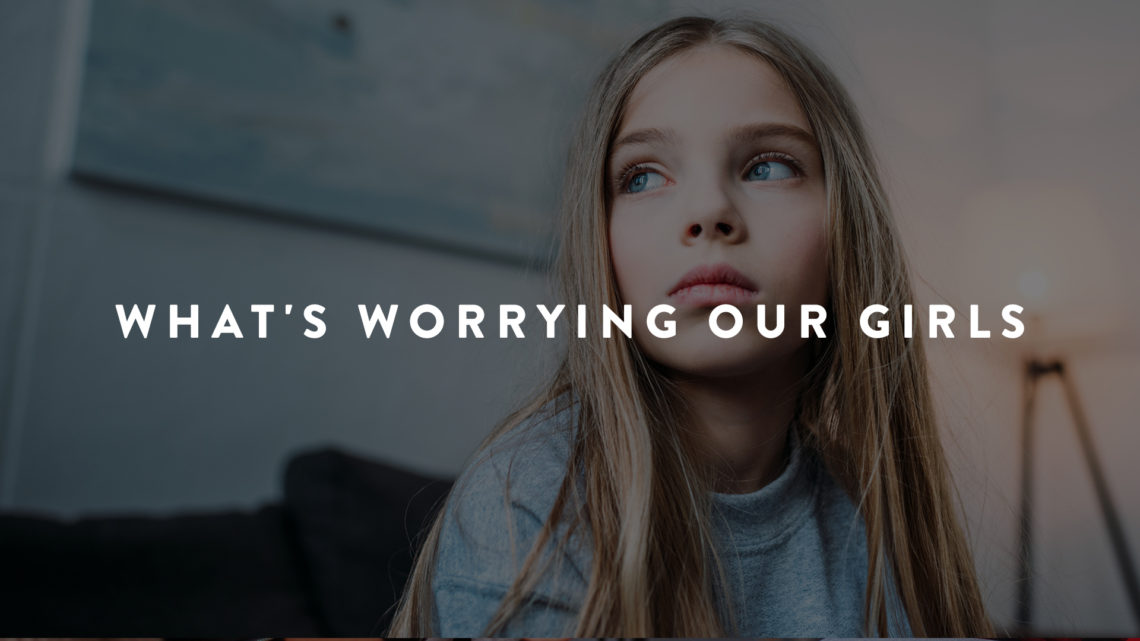
This is an excerpt from Raising Worry-Free Girls by Sissy Goff (used with permission)
What’s Worrying our Girls
By nature, girls want to please. Girls define themselves against a backdrop of relationship. Feeling known and loved is crucial. So to say something that might sound crazy or weird, or might make others reject them, can feel like a terrible risk. You might not like me anymore, they think. Even more than that, you might not love me. You might think I’m crazy. Maybe I am . . .
And so the thought that should be a flash gets stuck. It becomes what I refer to daily in my offices as the one-loop roller coaster at the fair. The thought goes around and around and around in the quiet of kids’ heads and becomes deafening.
The Worry Monster
I feel sick. I’m going to throw up. I can’t go to school. No one there likes me. I have to check and recheck this until I get it right. I can’t mess up. A little fear becomes a big worry. And that worry loops around and around and around . . . until it feels a lot like a gigantic, catastrophic, insurmountable monster of anxiety. We’ll call him the Worry Monster.
In her worries, your daughter often feels alone. She doesn’t know that others feel the same way, because it’s too scary to put her worries into words. Maybe people won’t like her. Or they’ll think she’s weird. So she thinks she’s the only one and that something is wrong with her.
This isn’t unusual. When something goes wrong in a girl’s world, she usually blames herself. (Boys are much more likely to blame someone else, such as Mom. Sorry, moms.)
How Parents Can Help
It doesn’t help that we adults often don’t know she’s battling a worry monster. We only see her tears. Or anger. Or hear the endless questions. Her outsides don’t match her insides, and her worries come out sideways through a whole host of other emotions. We don’t understand. Neither does she.
The more she listens to the tricks the Worry Monster tries to play on her, the stronger he gets. But the more we learn about her Worry Monster, the weaker he gets.
When your daughter has a little help, a lot of empowerment, and a foundational faith, worries don’t have to carry the same power in her life.
It’s how you and she respond that makes the difference. Our goal is to understand fear, move through worries, and help her not get stuck in a loop of anxiety.
When Worry Turns Into Anxiety
Worry turns into anxiety for a variety of reasons. Trauma can cause a child who worries to develop anxiety. Genetics can, as well. Personality, environment, life circumstances, and a whole host of factors can cause a child who worries to become a child with anxiety. As I said, fears pass with time, experience, and trust. Worries come and go, for all of us. But anxiety, left untreated, only gets worse.
With anxiety, we’ve got a really wide scope. It’s not “of” or “about” something. It’s “I have” or “I am.”
It’s a state of being: “I have anxiety,” “I am anxious.” And sadly, this state often comes to define us or the kids we love. In all my years of counseling, I’ve never had so many girls give me “I am” statements as they have about anxiety in the past five or so years.
Just as there is a continuum from fear to anxiety, there is also a continuum within anxiety itself.
Anxiety looks different on different girls. It varies in intensity and expression.
Girls with anxiety overestimate the threat and underestimate themselves and their ability to cope. The worst-case scenario becomes a normal life perspective.
Another primary factor of anxiety is that anxiety is born out of fear but has a response that is disproportionate to the fear itself.
Why Her?
Maybe you’ve noticed that your daughter seems to have more fears than her friends do. Maybe she talks often about worst-case scenarios. Maybe her teacher has mentioned anxiety. Or your girl has. Whatever the situation, I know you want your daughter to feel braver, stronger, and smarter. You want her to have a faith that brings her peace and comfort. But, right now, it’s not happening. The Worry Monster seems to have a bigger voice than she does. And, because her Worry Monster is in control, your Worry Monster is starting to turn up the volume with you.
I got a text from a friend this week who knew I was working on this book. “Here’s the deal,” she said. “We want to know:
- How we can help our kids, and
- What we did to cause this problem. We’re all feeling a lot of mom guilt over here.”
I do not want you to be reading this with, or out of, mom guilt or dad guilt or anyone guilt. If your daughter is a worrier or has anxiety, I know you may be asking yourself, “Why her?” She is very likely asking herself, “Why me?”
Let me tell you what I say to every girl facing anxiety: “You feel this way because you’re really great. The smartest, most conscientious, try-hard, care-about-things girls I know are the ones who struggle with anxiety. It’s honestly because you’re awesome. You care so much, and that’s the bottom line of why you worry.”
I’m serious, let’s start there. The girls I see who live with anxiety are some of the most hardworking, caring, intentional, kind, brilliant girls I know. Things matter to them. Everything matters to them, which can make life hard. And it can make it hard to know when or how to turn that kind of care off.
She’s Not Alone
Also, it’s helpful for her to know she’s in good company. I tell girls that anxiety is the primary mental health problem among children and teens. Not that I would use that the phrase “mental health” in my office with girls themselves, necessarily.
But it does help her a lot to know she’s not the only one struggling. I explain it more like, “I talk to girls every day who worry more than they wish they would. They have trouble turning those good brains of theirs off, and so they have lots of looping thoughts.
And believe me, I have heard girls say they’re worried about everything you can imagine. There is nothing you could say that would surprise me or make me think less of you.”





